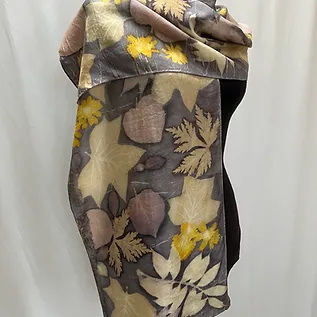 Topic: Botanical Printing with Mayumi Fugio
Topic: Botanical Printing with Mayumi Fugio
Speaker: Mayumi Fujio
Website: https://www.mayumix.com
Learn to create beautiful prints using fresh leaves, flowers and minerals. Mayuymi will teach us how to transfer these natural colors and shapes from plants onto silk fiber. You will have a lovely scarf to take home.
Click here to register.
Botanical printing and dyeing are creative processes that involve using plant materials to transfer their pigments and patterns onto fabric or paper. These techniques have been employed for centuries and are often considered a form of eco-friendly and sustainable art. Here’s an overview of each:
- Botanical Printing:
- Process: Also known as eco-printing, botanical printing involves placing plant materials, such as leaves, flowers, and stems, onto fabric or paper. The plant materials are arranged on the substrate, and pressure and heat are applied to transfer the pigments and shapes onto the surface.
- Materials: Leaves and other plant parts are chosen for their ability to release natural dyes and pigments. Common choices include eucalyptus, maple, rose, and fern leaves.
- Mordants: Sometimes, mordants (substances that fix the dye to the fabric) are used to enhance the color and longevity of the prints. Common mordants include alum and iron.
- Botanical Dyeing
- Process: Botanical dyeing involves extracting pigments from plant materials to create natural dyes, which are then used to color fabric or yarn. The fabric is typically treated with a mordant before dyeing to improve colorfastness.
- Materials: Various plant parts can be used for dyeing, such as roots, bark, leaves, flowers, and even fruit peels. Different plants produce different colors, and sometimes, the color may vary based on the mordant used.
- Mordants: Mordants play a crucial role in botanical dyeing, helping the dye adhere to the fabric fibers and improving color intensity. Common mordants include alum, iron, and tannin-rich substances.
Both botanical printing and dyeing allow artists and craftspeople to create unique, one-of-a-kind designs and colors from nature. The final results often depend on factors such as the type of plant materials used, the fabric, yarn or paper substrate, the mordants employed, and the application techniques.
These techniques are valued not only for their aesthetic appeal but also for their sustainable and environmentally friendly nature, as they utilize natural materials and reduce the reliance on synthetic dyes with potentially harmful chemicals. Additionally, the unpredictability of outcomes adds an element of surprise and creativity to the process, making each piece truly unique.
Note: The above article was generated by ChatGPT